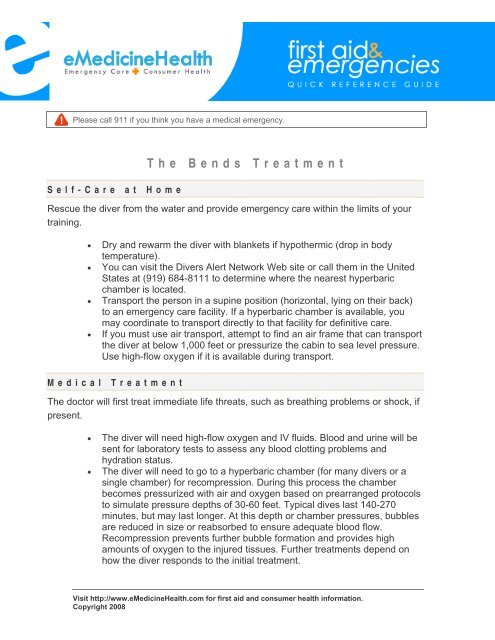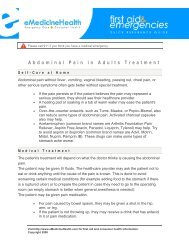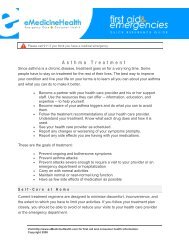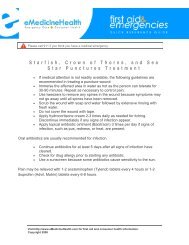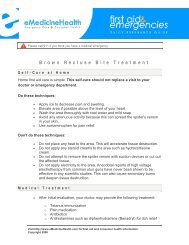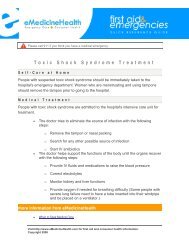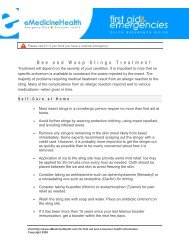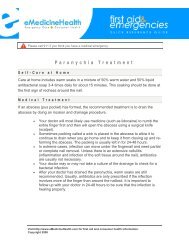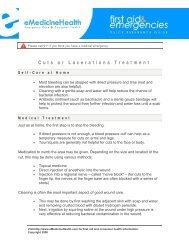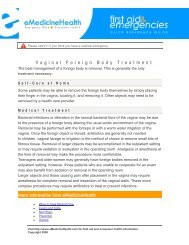The Bends Treatment - First Aid & Emergencies Quick Reference ...
The Bends Treatment - First Aid & Emergencies Quick Reference ...
The Bends Treatment - First Aid & Emergencies Quick Reference ...
Create successful ePaper yourself
Turn your PDF publications into a flip-book with our unique Google optimized e-Paper software.
Please call 911 if you think you have a medical emergency.<br />
Self-Care at Home<br />
<strong>The</strong> <strong>Bends</strong> <strong>Treatment</strong><br />
Rescue the diver from the water and provide emergency care within the limits of your<br />
training.<br />
• Dry and rewarm the diver with blankets if hypothermic (drop in body<br />
temperature).<br />
• You can visit the Divers Alert Network Web site or call them in the United<br />
States at (919) 684-8111 to determine where the nearest hyperbaric<br />
chamber is located.<br />
• Transport the person in a supine position (horizontal, lying on their back)<br />
to an emergency care facility. If a hyperbaric chamber is available, you<br />
may coordinate to transport directly to that facility for definitive care.<br />
• If you must use air transport, attempt to find an air frame that can transport<br />
the diver at below 1,000 feet or pressurize the cabin to sea level pressure.<br />
Use high-flow oxygen if it is available during transport.<br />
Medical <strong>Treatment</strong><br />
<strong>The</strong> doctor will first treat immediate life threats, such as breathing problems or shock, if<br />
present.<br />
• <strong>The</strong> diver will need high-flow oxygen and IV fluids. Blood and urine will be<br />
sent for laboratory tests to assess any blood clotting problems and<br />
hydration status.<br />
• <strong>The</strong> diver will need to go to a hyperbaric chamber (for many divers or a<br />
single chamber) for recompression. During this process the chamber<br />
becomes pressurized with air and oxygen based on prearranged protocols<br />
to simulate pressure depths of 30-60 feet. Typical dives last 140-270<br />
minutes, but may last longer. At this depth or chamber pressures, bubbles<br />
are reduced in size or reabsorbed to ensure adequate blood flow.<br />
Recompression prevents further bubble formation and provides high<br />
amounts of oxygen to the injured tissues. Further treatments depend on<br />
how the diver responds to the initial treatment.<br />
Visit http://www.eMedicineHealth.com for first aid and consumer health information.<br />
Copyright 2008
eMedicineHealth.com <strong>First</strong> <strong>Aid</strong> <strong>Quick</strong> <strong>Reference</strong> | Decompression Syndromes: <strong>The</strong> <strong>Bends</strong><br />
<strong>Treatment</strong><br />
• Often the person is admitted to the hospital to monitor medical condition<br />
and to ensure that there is no recurrence of symptoms.<br />
more information from eMedicineHealth<br />
• When to Seek Medical Care<br />
• Next Steps<br />
• Prevention<br />
• Outlook<br />
For more information, read the complete article, Decompression Syndromes: <strong>The</strong><br />
<strong>Bends</strong> (http://www.emedicinehealth.com/script/main/art.asp?articlekey=58666) on<br />
http://www.emedicinehealth.com.<br />
WebMD Medical <strong>Reference</strong> from eMedicineHealth<br />
Reviewed by Cynthia Haines, MD on May 24, 2006<br />
Last updated: May 24, 2006<br />
This information is not intended to replace the advice of a doctor.<br />
© 2006 WebMD Inc. All rights reserved.<br />
Visit http://www.eMedicineHealth.com for first aid and consumer health information.<br />
Copyright 2008


